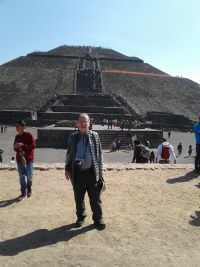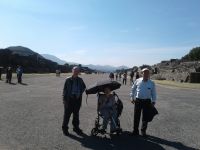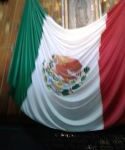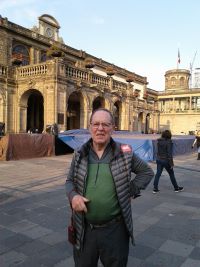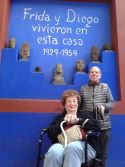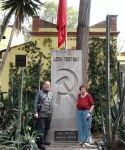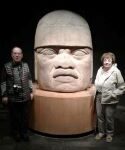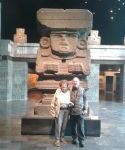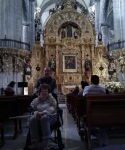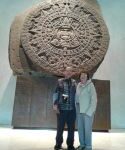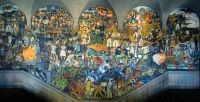January 6, 2019
We left Mexico City yesterday to come 150 miles north to San Miguel de Allende, birthplace of one of the four heroes of Mexican independence. Mexico City of 9-25 million was much more modern than I expected. I should know better; the capitals of major countries tend to be ponderous and pretentious, designed to impress. The Avenue of the Reforma, near Chapultepec Hill, is a wide boulevard with skyscrapers and Starbucks (signs in Spanish), with the Coyoacan neighborhood (home of Trotsky and friends) retaining some local charm including a few 16th century colonial buildings. Despite heavy traffic, we were able to move around the city fairly easily.
The road here, for much of the way, was modern expressway. It goes up to the US border (Laredo) and partly as a consequence has helped propel Quetaranos into one of the fastest growing cities in the northern hemisphere. It’s the location of macquadillories, the kind of special economic zones for the production of a variety of goods; one of the signs was in Japanese if that tells you anything. I didn’t read the Lonely Planet guidebook until we got here, so I learned to my regret that the Treaty of Guadalupe Hidalgo was signed here, ending the Mexican-American war; and I hope to be able to stop on our way to the airport to visit the site where Emperor Maximilian met his end.
When we left the interstate to come the remaining 30 kilometers, we were on the two-lane highway I had fancied more typical of transportation here.
When we got to San Miguel De Allende, I saw what our hotelier in Mexico City called the “real Mexico.” It got UNESCO’s World Heritage status about 20 years ago, got discovered by rich foreigners (over 12,000 foreigners call SMDA home), in addition to beatniks and artists, and got pricey. Several of the restored colonial homes are listed with Sotheby’s and Christie’s, which makes them expensive, indeed.
T he Rosewood, where we are staying, is a case in point. When we got here, we thought, “Aha, an old monastery, restored, like the five-star hotel we stayed in in Cartagena.” It had the wondrous courtyard so typical of
he Rosewood, where we are staying, is a case in point. When we got here, we thought, “Aha, an old monastery, restored, like the five-star hotel we stayed in in Cartagena.” It had the wondrous courtyard so typical of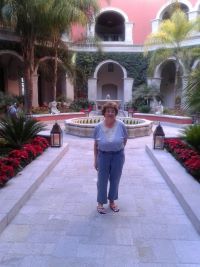 the Spanish colonial architecture, wide verandas like cloisters, beautiful landscaping. Bad guess, though; not 1670, not even 1970, but 2011. And the area, at the edge of the old colonial district, was cleared of trees to build condos which have access to all the amenities of the Rosewood.
the Spanish colonial architecture, wide verandas like cloisters, beautiful landscaping. Bad guess, though; not 1670, not even 1970, but 2011. And the area, at the edge of the old colonial district, was cleared of trees to build condos which have access to all the amenities of the Rosewood.
On our tour of the city, I could easily see the attractions—weather and ambience, the latter partly a function of a history that goes back to the 1540s, when some Franciscans who had settled in the valley discovered a spring, and moved the mission up on the hillside, building a chapel there that has a cross that’s over 300 years old. The move might also have been due to attacks from indigenous tribes.
The city really prospered from its proximity to Guanajuato (later), where silver and other minerals were discovered. The town square, typical in the Spanish settlements, was where the church was built, and the prominent local families, who serviced Guanajuato with produce, meat, leather, etc., built houses that were enviable for size and grace. One such was the property of the Allende family. It’s now a museum, and the upper floor recreates the lifestyle of the late 18th century. The lower floor discusses the quest for independence, which was spearheaded by Ignacio Allende, a Creole (Spanish, born in the new world) who was the military leader of the Independence movement.
As in Colombia, the immediate trigger was Napoleon’s invasion of Spain and his removal of the king in favor of his brother, Joseph. Joseph appointed new officials, and the question was whether to support the deposed Ferdinand, accept French/Spanish rule—or seek independence. The long simmering resentment of the Creoles against first Spanish mercantilism (all local industry existed at sufferance of the mother country; the vineyards here were burned, and locally-grown wine did not make its reappearance in this state until about 15 years ago), then “regalism,” the Enlightened despotism that centralized control under Spain (including banishing the popular Jesuits) exploded.
A regional junta was planning a revolt in October 1810, but it was a hard secret to keep; conspirators moved the date to September 1810, when a priest in nearby Delores, Miguel Hidalgo (who knew 7 languages—3 European, three Indian, and Latin) gave an impassioned speech, the Grito (Cry) Independence, in which he urged Creoles not to be cowards. That ignited a 11-year battle, by which time Hidalgo and Allende were dead (both by 1811), and why the two towns have new last names.
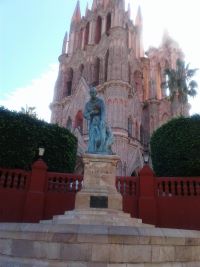 One of the most notable features of San Miguel is the big church, which in the late 19th century got an addition—a new façade based on what someone had seen apparently on a postcard from Cologne. I knew I’d seen that style before!
One of the most notable features of San Miguel is the big church, which in the late 19th century got an addition—a new façade based on what someone had seen apparently on a postcard from Cologne. I knew I’d seen that style before!
That leaves our third town in this area—Guanajuato—is a city of 760,000 people on a fairly steep hillside that is the reason for the settlement; those dormant volcanoes have helped Mexico provide something like 20% of the world’s supply of silver. Even today, the city’s economy is primarily dominated by mining, but tourism is a close second, and education is a third. In addition to the usual splendid baroque churches (Jesuit, Dominican and Franciscan), plazas and squares, the seat of the state’s government (some meeting in what had been a mine baron’s hacienda, that’s how big they were), there’s a major university.
Several of the most unusual features were the product of one of Guanajuato’s most famous sons—Porfirio Diaz. Elected president, he enjoyed the role so much he did not give it up until the Revolution (of 1910). 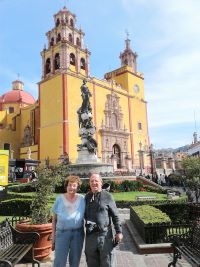 Supported by the wealthy miners (you should see and compare the Franciscan church in Guanajuato, sponsored by the wealthy, with the Jesuit one, a relatively somber but restful spare Gothic church), Diaz graced his city with a Teatro for all the world looking like something in Paris (our guide said Diaz leaned toward Europe since he and the Americans did not always see eye to eye), and a covered market ala Les Halles in Paris. The other
Supported by the wealthy miners (you should see and compare the Franciscan church in Guanajuato, sponsored by the wealthy, with the Jesuit one, a relatively somber but restful spare Gothic church), Diaz graced his city with a Teatro for all the world looking like something in Paris (our guide said Diaz leaned toward Europe since he and the Americans did not always see eye to eye), and a covered market ala Les Halles in Paris. The other 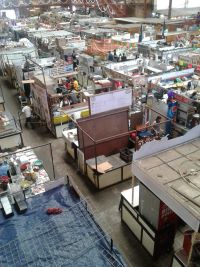 feature that struck me was that the city builders used tunnels to connect the parts of the city—the early ones with hammer and chisel (and dynamite), the same tools used in silver mining. They also had to build up the city, which flooded several times. The original floor of the big church is about ten feet below the current level.
feature that struck me was that the city builders used tunnels to connect the parts of the city—the early ones with hammer and chisel (and dynamite), the same tools used in silver mining. They also had to build up the city, which flooded several times. The original floor of the big church is about ten feet below the current level.
Well, tomorrow we go back to Mexico City on our way home. From 20 degrees (Centigrade) to 20 degrees (Fahrenheit).
